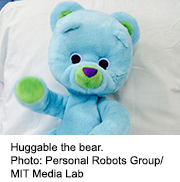- How Daily Prunes Can Influence Cholesterol and Inflammation
- When to Take B12 for Better Absorption and Energy
- Epsom Salts: Health Benefits and Uses
- See What Saffron Can Do for Sleep and Heart Health
- 6 Common Mistakes to Avoid Before Your Physical
- Can Sweating Really Help You Beat a Cold?
- Strengthening Your Relationship: Practical Strategies
- Skip Storing This Everyday Product in the Fridge Door
- Green Tea + B3 Pairing May Boost Brain Health
- Navigating Your Midlife Crisis: Embracing New Possibilities
Meet ‘Huggable,’ the Robot Bear Who’s Helping Hospitalized Kids

He sings, he plays games — and Huggable the ‘social robot’ teddy bear could be good medicine for kids in the hospital.
In a study of 50 children, aged 3 to 10 years, the plush bear boosted spirits, eased anxiety and even lowered perceived pain levels, say Boston Children’s Hospital researchers.
“It’s exciting knowing what types of support we can provide kids who may feel isolated or scared about what they’re going through,” said study first author Deirdre Logan, a pediatric psychologist at the hospital.
Logan noted that hospital staffers provide a lot of support to help kids feel comfortable, but they can’t be with every kid all the time.
“Social robots create a more consistent presence throughout the day,” Logan said. “There may also be kids who don’t always want to talk to people, and respond better to having a robotic stuffed animal with them.”
The robot is not designed to replace health care specialists, only to assist them, the study authors noted.
Study co-author Cynthia Breazeal, founding director of the Personal Robots Group at Massachusetts Institute of Technology, said, “Our group designs technologies with the mindset that they’re teammates … We want technology to support everyone who’s invested in the quality care of a child.”
For the study, the researchers split the young patients into three groups: One used the robotic teddy; another group used a tablet-based, virtual Huggable; and the third group had traditional teddy bears.
The robotic teddy bear is operated by a specialist in the hall outside a child’s hospital room. The specialist controls the robot’s facial expressions and body actions, directs its gaze, talks through a speaker that shifts the voice to a higher pitch to sound more childlike, and monitors the patient via camera.
The specialist sang nursery rhymes to younger children and moved the robotic bear’s arms during the song, and played the “I Spy” game with older patients.
The tablet-based, virtual Huggable had identical gestures and was also remotely operated.
But kids preferred playing with the Huggable robot to either the virtual version or a traditional teddy bear, according to the study published online June 26 in the journal Pediatrics.
Kids who played with the robot got out of bed and moved around more and made an emotional connection with the robot, asking it personal questions and inviting it to come back later to meet their families. Parents reported their kids had less pain when they interacted with the robot.
“Such improved emotional, physical and verbal outcomes are all positive factors that could contribute to better and faster recovery in hospitalized children,” the researchers concluded in their report.
More information
The American Academy of Pediatrics offers advice for parents when a child needs emergency hospital care.
Source: HealthDay
Copyright © 2026 HealthDay. All rights reserved.










